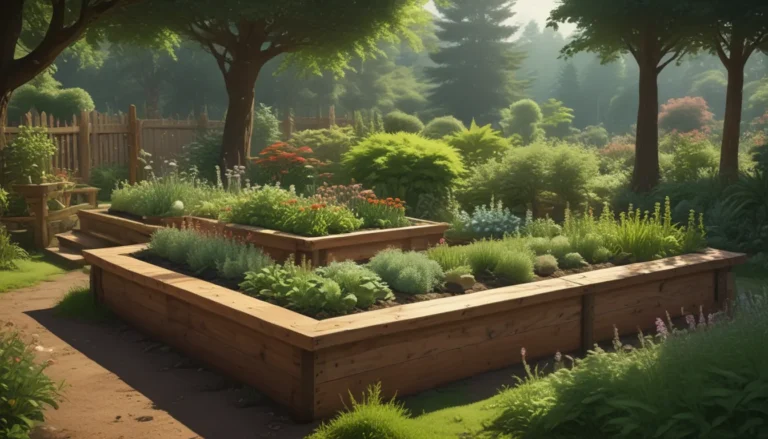A Comprehensive Guide to Growing and Caring for Ginseng Ficus

The Fascinating World of Ficus Microcarpa
Ginseng figs, scientifically known as Ficus microcarpa, are delightful houseplants that are often seen as potted bonsai trees. Also referred to as curtain figs, Indian laurel, Chinese or Malayan banyan, or simply banyan trees, these plants are versatile and captivating additions to any indoor space.
The unique characteristics of Ficus microcarpa make them a favorite among plant enthusiasts. From their gentle demeanor as indoor houseplants to their ability to transform into massive trees up to 50 feet tall, these plants exhibit a wide range of diversity that ensures they can thrive both indoors and outdoors.
In this article, we will delve into various aspects of growing and caring for ginseng ficus to help you nurture a healthy and flourishing plant at home or in the office.
What You’ll Discover
- Cultivation and History
- Propagation Techniques
- Growing Tips and Tricks
- Pruning and Maintenance Practices
- Cultivar Selection
- Pest and Disease Management
- Best Uses and Applications
- Quick Reference Growing Guide
Ficus plants are renowned for their popularity as houseplants, with species like the fiddle-leaf figs and rubber trees also belonging to the Ficus genus.
Cultivation and History of Ginseng Ficus
Originating from regions in Southeast Asia, Australia, India, Japan, Nepal, and the Himalayas, ginseng figs have made their way to various parts of the world, including California, Florida, Hawaii, Spain, South America, and the Caribbean.
Initially starting as epiphytes on other plants, these versatile trees transition into terrestrial trees by developing aerial roots. They boast small oval-elliptic leaves with smooth gray bark and are famous for their unique growth pattern.
In their natural habitat, ginseng ficus trees can reach heights of up to 50 feet and feature a rounded crown. While traditional flowers are absent, their fig fruits house hidden flowers critical for pollination.
These plants thrive both indoors and outdoors, adapting well to different environmental conditions. When grown indoors, ginseng ficus remain compact, only reaching heights of six to seven feet.
Ginseng Fig Propagation Made Easy
Propagation of Ficus microcarpa can be effortlessly achieved through various methods, including air layering and stem cuttings.
Air Layering:
- Choose a healthy branch with a pencil-like diameter.
- Gently remove the bark from a section of the branch using a sharp, clean knife.
- Wrap the exposed section with moistened sphagnum moss and secure with clear plastic.
- Ensure the moss remains moist until roots form.
- Once roots are visible, cut the branch below the rooting area and plant it separately in a container.
Stem Cuttings:
- Take a four- to six-inch cutting of a mature branch.
- Remove lower leaves and place in a potting mix or water.
- Provide bright, indirect light for root development.
- Check soil moisture and root growth progress regularly.
Both propagation methods offer practical means of expanding your ginseng ficus collection.
Transplanting:
- Transfer new plants to appropriately sized containers upon purchase.
- Ensure soil is moist and well-draining to promote healthy root growth.
- Place the plant at the same level in the new container, filling in with fresh potting mix.
How to Successfully Grow Ginseng Ficus
Maintaining your ginseng ficus involves providing adequate lighting, watering, and temperature levels.
- Gradually introduce the plant to direct sunlight.
- Keep soil moist but not saturated, allowing the top inch to dry out.
- Maintain temperatures between 60 and 85°F.
- Use well-draining soil mixes for optimal growth.
Ginseng ficus thrives in bright, indirect light and adapts well to various lighting conditions.
Growing Tips for Ginseng Ficus
- Gradually increase direct light exposure.
- Allow soil to partially dry between waterings.
- Maintain temperatures above 50°F for optimal growth.
These tips will help you cultivate a healthy and vibrant ginseng ficus plant.
Pruning and Maintenance Essentials
Regular maintenance of your ginseng ficus involves minor pruning and monitoring for signs of distress.
- Wipe leaves to remove dust accumulation.
- Prune damaged or diseased branches following the four Ds rule.
- Feed monthly with a balanced fertilizer.
- Repot every two to three years as needed.
Keeping your plant healthy through proper care and maintenance practices ensures long-term growth and vitality.
Ginseng Fig Cultivars to Explore
Choosing the right cultivar can enhance the aesthetics and growth habits of your ginseng ficus plant.
- Compacta: A compact option ideal for indoor spaces, reaching heights of five feet with dense foliage.
- Golden Gate: A favorite for bonsai enthusiasts, featuring smaller leaves and a bright green hue.
- Green Island: A versatile cultivar suitable for both indoor and outdoor settings, growing up to three feet tall.
- Moclame: A low-light tolerant variety with a compact growth habit.
- Mini Flat Leaf: A dwarf cultivar perfect for bonsai enthusiasts with cascading foliage.
Exploring different ginseng ficus cultivars allows for creative growth opportunities and unique plant displays.
Managing Pests and Diseases with Care
Keeping your ginseng ficus healthy involves preventive measures against common pests and diseases.
Pests to Watch Out For:
- Mealybugs: Sap-sucking insects causing yellowing and leaf drop.
- Spider Mites: Tiny bugs feeding on leaves and stems, producing fine webbing.
Disease Prevention:
- Root Rot: Caused by excessive moisture, leading to root decay and leaf discoloration.
Monitoring for pests and signs of disease ensures early detection and effective mitigation measures for a thriving plant.
Best Uses and Applications of Ginseng Ficus
Ginseng ficus plants offer versatile applications as bonsai trees, indoor shrubs, or potted specimens.
- Ideal for bonsai training with unique growth patterns and aesthetic appeal.
- Suitable for indoor display as single specimens or decorative topiary.
Exploring the diverse uses of ginseng ficus allows for creative plant arrangements and personalized growth projects.
Quick Reference Growing Guide for Ginseng Ficus
- Plant Type: Evergreen epiphyte
- Hardiness (USDA Zones): 9-11
- Exposure: Bright, indirect light
- Water Needs: Moderate
- Maintenance: Low
- Soil Type: Light, airy
- Maturity: >10 years
- Common Pests: Mealybugs, spider mites
- Height: 7 feet (indoors) over 50 feet (outdoors)
Utilize this quick reference guide for easy access to essential information on growing and caring for ginseng ficus plants.
Conclusion: Embrace the Beauty of Ginseng Ficus
With their adaptable nature and captivating growth habits, ginseng ficus plants are ideal choices for both novice and experienced plant enthusiasts. Through proper cultivation, maintenance, and creative exploration of cultivar options, you can enjoy the beauty and elegance of these versatile houseplants.
Which cultivar will you choose for your ginseng ficus plant? How do you envision its growth and display in your home or office? Share your thoughts and experiences with fellow plant lovers in the comments below.
By following the valuable information and tips provided in this comprehensive guide, you can cultivate a thriving and vibrant ginseng ficus plant that adds joy and greenery to your indoor space.
Explore the fascinating world of Ficus microcarpa and embrace the beauty of ginseng ficus plants in your growing journey. For more insights on ficus plants and related topics, consider exploring our other informative plant guides for additional knowledge and inspiration.
Incorporating various sections, expanded content, and useful tips, this rewritten article transforms into a comprehensive guide filled with valuable information and insights for ginseng ficus enthusiasts. Embracing a conversational and educational tone, this enhanced version aims to provide an engaging and informative resource for readers seeking to cultivate healthy and thriving ginseng ficus plants.





